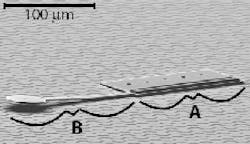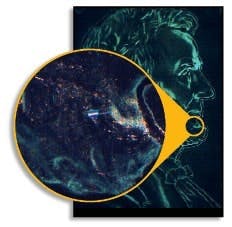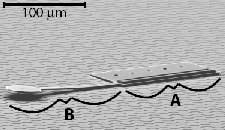Nano-size me!
THE WELL-WORN saying that the world is getting smaller might not have anticipated this: Dartmouth College researchers have created the world's smallest untethered, controllable robot. The machine is about as wide as a strand of human hair and half the length of the period at the end of this sentence. According to the college, about 200 of these could march in a line across the top of a piece of M&M candy.The researchers, led by Bruce Donald, computer science professor at Dartmouth, reported their “creation” in a paper presented at the 12th International Symposium of Robotics Research last month in San Francisco.
"It's tens of times smaller in length, and thousands of times smaller in mass than previous untethered microrobots that are controllable," says Donald. "When we say 'controllable,' it means it's like a car; you can steer it anywhere on a flat surface, and drive it wherever you want to go. It doesn't drive on wheels, but crawls like a silicon inchworm, making tens of thousands of 10-nanometer steps every second. It turns by putting a silicon 'foot' out and pivoting like a motorcyclist skidding around a tight turn."Future applications for micro-electromechanical systems (MEMS) include inspecting and making repairs to an integrated circuit, exploring hazardous environments after a hazardous chemical explosion, or involving biotechnology, perhaps to manipulate cells or tissues.The researchers’ paper describes a machine that measures 60 x 250 µm (one micrometer is 1,000th of a millimeter). It integrates power delivery, locomotion, communication, and a controllable steering system—the combination of which reportedly has never been achieved before in a machine this small. Donald said this discovery ushers in a new generation of even tinier microrobots."Machines this small tend to stick to everything they touch, the way the sand sticks to your feet after a day at the beach,” says Craig McGray, who earned a Ph.D. in computer science working on this project in Donald's lab. “So we built these microrobots without any wheels or hinged joints, which must slide smoothly on their bearings. Instead, these robots move by bending their bodies like caterpillars. At very small scales, this machine is surprisingly fast."The prototype is steerable and untethered, so it moves freely on a surface without the wires or rails that constrain the motion of previously developed microrobots.Donald explains that this is the smallest robot that transduces force, is untethered, and is engaged in its own locomotion. The robot contains two independent microactuators, one for forward motion and one for turning. It's not pre-programmed to move, he says. It is teleoperated, powered by the grid of electrodes it walks on. The charge in the electrodes not only provides power, it also supplies the robot's instructions that allow it to move freely over the electrodes, unattached to them.



